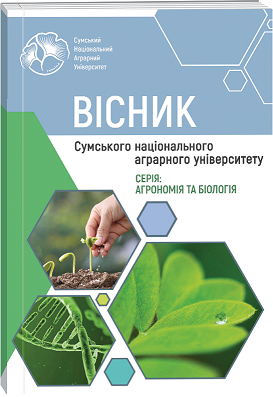DETERMINATION OF ALFALFA RESISTANCE TO ATRAZINE
Abstract
With the rapid development of animal husbandry, finding efficient and sustainable feed resources has become an important issue for the industry's development. Alfalfa is rich in nutrients and has the characteristics of rapid growth and good palatability, which has attracted the attention of many dairy farmers. Atrazine is one of the commonly used herbicides in corn crop, and corn-alfalfa rotation is a common planting mode in the world. However, alfalfa is extremely sensitive to herbicides, so it is crucial to study the resistance of alfalfa to them. Indoor bioassay is a commonly used method for identifying herbicide resistance in crops, which has been widely applied in the study of tolerance to herbicides such as bensulfuron methyl in crops such as alfalfa and soybean. However, there are few reports on indoor bioassay methods for herbicide resistance in alfalfa and related studies on herbicide tolerance in alfalfa. The purpose of this study is to analyze the fresh weight of 60 alfalfa varieties under herbicide stress, to screen resistant and sensitive alfalfa varieties to herbicide influence, to determine the resistance level of alfalfa varieties to herbicide, and to provide theoretical reference for a deeper understanding of herbicide resistance mechanisms and variety improvement in alfalfa. This experiment used the potted soil toxicity method to determine the resistance of 60 alfalfa varieties. The pre experiment concentrations were set as follows: 5.00, 10.00, 20.00, 40.00, 80.00, and 160.00 mg/kg (for resistance determination) and 0.025, 0.05, 0.10, 0.20, 0.40, and 0.80 mg/kg (for sensitivity determination. The most resistant variety (SF8001) and the most sensitive variety (Juneng 2) to atrazine were screened. Among them, the IC50 of SF8001 was 14.875, and the IC50 of Juneng 2 was 0.2428. Compared with the variety Juneng 2, the resistance multiple (RI) of SF8001 was 61.26. The experimental results indicate that residual herbicides can have toxic effects on alfalfa, and different types of alfalfa have different resistance to herbicides. This provides a theoretical basis for the study of resistance mechanisms and a scientific basis for the selection of alfalfa varieties for rotation planting in corn crop.
References
2. Cooper, R.L., Laws, S.C., Das, P.C., Narotsky, M.G., Goldman, J.M., Lee, T.E., & Stoker, T.E. (2007). Birth Defects Research Part B: Developmental., Toxicology Reproductive, Atrazine and reproductive function: mode and mechanism of action studies. 80(2), 98-112. doi: 10.1002/bdrb.20110
3. Cooper, R.L., Stoker, T.E., Tyrey, L., Goldman, J.M., & McElroy, W. K. (2000). Atrazine disrupts the hypothalamic control of pituitary-ovarian function. Toxicological sciences. 53(2), 297-307. doi:10.1093/toxsci/53.2.297
4. Griffin, J.L., Bauerle, M.J., Stephenson, D.O., Miller, D. K., & Boudreaux, J.M. (2013). Soybean response to dicamba applied at vegetative and reproductive growth stages. Weed Technology. 27(4), 696-703. doi:10.1614/WT-D-13-00084.1
5. Huang, X.W., Yang, X.L., Lin, J.H., Franks, A.E., Cheng, J., Zhu, Y. J., Shi, J.C., Xu, J.M., Yuan, M., Fu, X.J., & He, Y. (2022). Biochar alleviated the toxicity of atrazine to soybeans, as revealed by soil microbial community and the assembly process. Science of The Total Environment. 83(4), 155-261. doi: 10.1016/j.scitotenv.2022.155261
6. Kooijman, S. A. (2007). A safety factor for LC50 values allowing for differences in sensitivity among species. Water Research. 21(3), 269-276. doi: 10.1016/0043-1354(87)90205-3
7. Lanie, A. J., Griffin, J. L., Reynolds, D. B., & Vidrine, P. R. (2005). Influence of residual herbicides on rate of paraquat and glyphosate in stale seedbed soybean (Glycine max). Weed Technology. 7(4), 960-965. doi:10.1017/S0890037X00038082
8. Lazorko-Connon, S., & Achari, G. (2009). Environmental reviews atrazine: its occurrence and treatment in water. Environmental Reviews. 17(42), 199-214. doi: 10.1139/A09-009
9. LeBlanc, A., & Sleno, L. (2011). Atrazine metabolite screening in human microsomes: detection of novel reactive metabolites and glutathione adducts by LC-MS. Chemical Research in Toxicology. 24(3), 329-339. doi: 10.1021/tx200008f
10. Metzger, B. A., Soltani, N., Raeder, A. J., Hooker, D. C., Robinson, D. E., & Sikkema, P. H. (2019). Effect of hybrid varieties, application timing, and herbicide rate on field corn tolerance to tolpyralate plus atrazine. Weed Science. 67(5), 475-484. doi:10.1017/wsc.2019.34
11. Robinson, D. E. (2008). Atrazine accentuates carryover injury from mesotrione in vegetable crops. Weed Technology. 22(4), 641-645. doi:10.1614/WT-08-055.1
12. Sher, A., Mudassir, M. M., Iqbal, J., Nadeem, M., Faiz, S., Noor, H., Hamid, Y., Yuan, X., & Ping, Y.G. (2021). The growth, physiological and biochemical response of foxtail millet to atrazine herbicide. Saudi J. Biol. Sci.m 28(11), 6471-6479. doi:10.1016/j.sjbs.2021.07.002
13. Shimabukuro, R.H., & Swanson, H.R. (2003). Chemistry food, atrazine metabolism, selectivity, and mode of action. Journal of Agricultural. 17(2), 199-205. doi: 10.1021/jf60162a044
14. Solomon, K. R., Carr, J. A., Du, P. L. H., Giesy, J. P., Kendall, R. J., Smith, E. E., Van, D., & Kraak, G. J. (2008). Effects of atrazine on fish, amphibians, and aquatic reptiles: a critical review. Critical reviews in toxicology 38(9), 721-772. doi: 10.1080/10408440802116496
15. Su, W. C., Sun, L. L., Ge, Y. H., Wu, R. H., Xu, H. L., & Lu, C. T. (2018). The residual effects of bensulfuron-methyl on growth and photosynthesis of soybean and peanut. Photosynthetica. 56(2), 670-677. doi: 10.1007/s11099-017-0726-z
16. Sukhov, V., Surova, L., Sherstneva, O., & Vodeneev, V. (2014). Influence of variation potential on resistance of the photosynthetic machinery to heating in pea. Physiologia Plantarum. 152(4), 773-783. doi: 10.1111/ppl.12208
17. Sun, L. L., Xu, H. L., Hao, H. D., An, S. H., Lu, C.T., Wu, R. H., & Su, W. C. (2019). Effects of bensulfuron-methyl residue on photosynthesis and chlorophyll fluorescence in leaves of cucumber seedlings. PloS One. 14(4), 5486. doi: 10.1371/journal.pone.0215486
18. Tappe, W. G., Groeneweg J., & Jantsch, B. (2002). Diffuse atrazine pollution in German aquifers. Biodegradation. 13(1), 3-10. doi: 10.1023/A:1016325527709
19. Topp, E., Zhu, H., Nour, S. M., Houot, S., Lewis, M., & Cuppels, D. (2000). Characterization of an atrazine-degrading Pseudaminobacter sp. isolated from Canadian and French agricultural soils. Applied. Microbiology Environmental. 66(7), 2773-2782. doi: 10.1128/AEM.66.7.2773-2782.2000
20. Udiković, K. N., Scott, C., & Martin, L. F. (2012). Evolution of atrazine-degrading capabilities in the environment. Applied microbiology, biotechnology, 96, 1175–1189. doi: 10.1007/s00253-012-4495-0
21. Vonberg, D., Hofmann, D., Vanderborght, J., Lelickens, A., Koppchen S., Putz, T., Burauel, P., & Vereecken, H. (2014a). Atrazine soil core residue analysis from an agricultural field 21 years after its ban. Journal of Environmental Quality, 43(4), 1450–1459. doi:10.2134/jeq2013.12.0497
22. Vonberg, D., Hofmann, D., Vanderborght, J., Lelickens, A., Köppchen, S., Pütz, T., Burauel, P., & Vereecken, H. (2014b). Atrazine soil core residue analysis from an agricultural field 21 years after its ban. Journal of environmental quality, 43(4), 1450–1459. doi: 10.2134/jeq2013.12.0497
23. Wackett, L., Sadowsky, M., Martinez, B., & Shapir, N. (2002). Biodegradation of atrazine and related s-triazine compounds: from enzymes to field studies. Applied Microbiology, Biotechnology, 58, 39–45. doi: 10.1007/s00253-001-0862-y
24. Wang, L., Samac, D. A., Shapir, N .R., Wackett, L. P., Vance, C. P., Olszewski, N. E., & Sadowsky, M. J. (2005). Biodegradation of atrazine in transgenic plants expressing a modified bacterial atrazine chlorohydrolase (atzA) gene. Plant Biotechnology Journal, 3(5), 475-486. doi: 10.1111/j.1467-7652.2005.00138.x
25. Yu, J., Bian, Z. Q., Tian, X. H., Zhang, J., Zhang, R., & Zheng, H. H, (2017). Atrazine and its metabolites in surface and well waters in rural area and its human and ecotoxicological risk assessment of Henan province, China. Human and ecological Risk Assessment: An International Journal, 24(1), 1–13. doi:10.1080/10807039.2017.1311768
26. Zhang, C. M., Shi, S. L., Liu, Z., Yang, F., & Yin, G. L. (2019). Drought tolerance in alfalfa (Medicago sativa L.) varieties is associated with enhanced antioxidative protection and declined lipid peroxidation. Journal of plant physiology, 232, 226–240. doi:10.1016/j.jplph.2018.10.023
27. Zhang, J. J., Lu, Y. C., Zhang, J. J., Tan, L. R., & Yang, H. (2014). Accumulation and toxicological response of atrazine in rice crops. safety environmental, 102, 105–112. doi:10.1016/j.ecoenv.2013.12.034
28. Zhu, A. M., Huang, W.L., Han, G. D., Zhang, Y. X., Wang, X. G., & Wu, Q. (2021). Response of physiological and biochemical characteristics of alfalfa with different root collar diameter to low temperature stress. Acta Agrestia Sinica, 29 (10), 2214. doi:10.11733/j.issn.1007-0435.2021.10.012
29. Zhu, J. W., Fu, L., Jin, C.H., Meng, Z. L., & Yang, N. (2019). Study on the isolation of two atrazine-degrading bacteria and the development of a microbial agent. Microorganisms. 7(3), 80. doi:10.3390/microorganisms7030080
30. Su, W. C., Ge, Y. H., Wu, R. H., Xu, H. L., Xue, F., & Lu, C.T. (2016). Effects of bensulfuron-methyl residue on photosynthesis traits and chlorophyll fluorescence of corn seedlings. Journal of Maize Sciences, 24, 67–74. doi: 10.13597/j.cnki.maize.science.20160612.
31. Sun, L. L., Xu H. L., Su W. C., Wu R. H., Xue F., & Lu C.T. (2019). Sensitivity and early diagnosis of bensulfuronmethyl residue to four crops. Agrochemicals, 58, 737–740. doi: 10.16820/j.cnki.1006-0413.2019.10.011.

 ISSN
ISSN  ISSN
ISSN 



